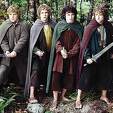











|
These categories of movies have always been very expensive and time consuming to produce. Probably the first real full length epic was Birth of a Nation in 1915 by D.W Grifith, a controversial film that is still being debated. The same director made the Intolerance in 1916. Both those movies are still being shown on TV and art houses almost a century later. Whether D.W Grifith was a racist or not, we cannot be sure. Remember that he also produced a warm portrayal of Abraham Lincoln, with Walter Houston as Lincoln, fifteen years later. However, as with Westerns and other movies we must look at these movies in the context of time in which they were produced. The movies reflect or mirror the attitude of a society during their period. It is easy to sit back and be a revisionist and condemn someone because we do not agree with his or her beliefs. Our purpose as movie critics is to judge movies on their entertainment, acting, continuity, story and direction value. The message delivered is important; however it has to be viewed in the context of time. Submit your Action/Adventure/Epic Review For example, until the sixties, Blacks and other minorities were stereotyped in negative or comical ways. The Chinese and the Japanese were always crafty and ruthless (with the exception of Charlie Chan who was crafty but on our side.) The Blacks were portrayed as not very clever and always performed menial jobs. From mid sixties it all changed. You seldom if ever saw a minority as a criminal unless he was part of gang with Whites. The minorities were portrayed as the good cops and the wise judges. This was nonsense, of course. The reasons were two folds, one was over compensation on the part of White liberal directors, the other fear of being labeled as racist. This portrayal did not change until Black directors started making movies and with movies such as Malcolm X and New Jack City they portrayed that Blacks, just like Whites, could be ruthless and savage or decent and law abiding. |
|||||||||
|
Many great movies were made during the late 1910's and 1920's right until the Sound Era. Douglas Fairbanks made The Thief of Baghdad (1924) and Robin Hood (1922). Rudolph Valentino starred in the Sheik (1921) and Blood and Sand in 1922. Rudolph Valentino achieved almost everlasting fame because of his general good looks and his eyes. It is thought that part of his attraction was because his eyes were closer to each other than most people and also he was short sighted. However, the most successful and durable movie of the time was the original Ben-Hur (1925.) Ben-Hur was one of the most expensive movies ever made with a cast of tens of thousands. The chariot race is still, to this day, exciting. One of the first sound epics was Cecil B. De Mille's Crusade (1935) starring Loretta Young and Henry Wilcoxon.The most successful film in the history of movie making until the 1960's was Gone with the Wind (1939) a David O. Selznick production starring Clarke Gable, Vivian Leigh and many other talented actors. A truly wonderful film that was true to its origins The availability of high fidelity sound and cheaper color stock made it easier to create epics in the fifties. Cecil B. DeMille produced The Ten Commandments (1956) Samson and Delilah (1949.) The latter starred the sultry Hedy Lamarr, who by the way was a brilliant engineer who invented Frequency Hopping that is used in wireless computer communications today and also a torpedo guidance system. MGM, for the first time shot a film on location. They shipped an entire crew and stars to Egypt to make Valley of the Kings (1954) with Robert Taylor, Eleanor Parker and their new discovery Carlos Thompson. Lana Turner had discovered Carlos in Argentina and had brought him back with her. The French director William Wyler produced Ben-Hur for MGM in 1959. 20 th Century Fox made Cleopatra in 1963. |
|||||||||
In the Fifties, the motion picture studios were facing bankruptcy due to the intense competition from television. In 1953, Twentieth Century Fox produced the first wide screen movie, The Robe with Richard Burton, Jean Simmons and Jay Robinson. It was soon followed by a sequel; Demetrius and the Gladiators. This event helped slow down the decline of Hollywood studios and many studios, except Paramount which implemented Vistavision instead, adopted the new technology. There were other wide screen technologies created such as Cinerama, Superscope and Cinescope. None became mainstream standards. The British also made a few notable epics, the most successful one being the Land of the Pharaohs with Jack Hawkins and Joan Collins. An interesting side note is that the Egyptian pyramid builders had to be dressed in loin cloth only, so when the extras were undressed, they found that they were aspirin white from the neck down to their waist lines. According to the director their bodies had to be actually painted every day. The Italian Renaissance in moviemaking continued in this genre as well although it was not ground breaking like their advances in Drama. Tapping into Roman and Greek mythology many movies about Hercules and other mythical characters were produced. Most of them starred US actors such as Steve Reeves and Gordon Scott. The directing and acting was not very good in these movies but nevertheless they were commercially successful. In the Sixties, The British director David Lean made the Lawrence of Arabia a major historical epic that still looks as fresh as when it was made. Stanley Kubrick produced Spartacus. The homosexual seduction scene between Laurence Olivier and Tony Curtis was excised by the censors until it was rediscovered in late nineties without the sound track. It was restored with Anthony Hopkins doing the voice over for Laurence Olivier. Charlton Heston's El Cid produced by Anthony Mann was not very successful despite its lavish location and its stars. Another failure of this decade was 55 Days at Pecking produced by Samuel Goldwyn. This movie was actually quite good. It starred Charlton Heston and Ava Gardner. If I am not mistaken, this movie bankrupted his studio. As we said earlier, epics are very expensive to produce and they usually star major celebrities which makes them even more expensive. For example for the Gladiator they actually had to construct a new Coliseum. Cleopatra went through directors. The studio, Twentieth Century Fox, initially, created the entire set in its English studios. However, the English weather did not oblige by becoming Egyptian, new sets had to be built in the Cinecitta studios in Italy. In 1968 when MGM was filming the Shoes of the Fisherman, the Vatican refused to allow MGM inside the Vatican. The studio had to create all the internal sets including the Sistine chapel from scratch. Probably the best epic of the first decade of this century was the Lord of the Rings Trilogy. Each episode was lavishly produced but there were no real major name stars in them. The movies were extremely successful and also won major awards. The new epic adventures continue. The Pirates of Caribbean and its sequel were expensive to produce but extremely profitable. Return of Superman is another expensive science fiction which could qualify as an adventure movie. |